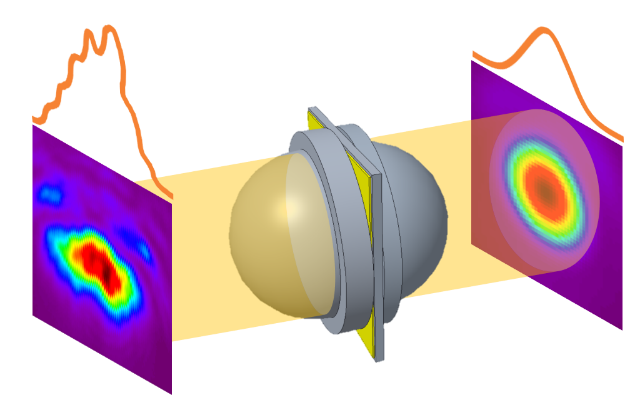Far-infrared telescopes mix the incoming light from space with their own far-infrared laser to maximize the spectral resolution. But the currently available lasers can’t produce a radiation signal with an ideal shape—a Gaussian beam. Yuner Gan, a PhD student at SRON and RUG, has now developed a beam cleaning device that reshapes an original laser beam into a Gaussian beam. Publication in Optics Express.
Objects in the Universe are so far away that even light needs sometimes billions of years to cross the distance. When the light finally arrives on Earth, it has diverged into such a weak signal that we can’t even see it anymore with our own eyes. Far-infrared telescopes have large mirrors to collect a maximum amount of light, but still we need all hands on decks to distinguish the individual spectral lines. Therefore we equip the telescopes with their own far-infrared source, to mix the incoming light with a known signal, resulting in a better spectral resolution. Unfortunately, the best available sources—quantum cascade lasers—have a beam shape that is far from ideal. This can cause loss of light while it travels from one element to another within an instrument, or it can make it difficult to predict the behavior of the light, and even create unwanted light seen by the detectors.

Gaussian beam
Yuner Gan, a PhD student at SRON Netherlands Institute for Space Research and University of Groningen, has now developed a device that reshapes a regular laser beam into an ideal shape—a Gaussian beam. It is a far-infrared filter consisting of two back-to-back mounted silicon lenses, with an opening aperture defined on a thin gold layer in between. When Gan applied the device to a quantum cascade laser at 3.9 THz with a poor beam, she obtained a Gaussian beam with over 30% transmission efficiency—the ratio of the energy in the output versus the input. This is still a significant efficiency taking into account the intrinsic 72% transmission of the two back-to-back silicon lenses without the aperture and also considering the relatively poor input beam.
This work is an international collaboration among SRON, University of Groningen, Delft University of Technology and Massachusetts Institute of Technology.
Publication
Yuner Gan, Behnam Mirzaei, Sebastiaan van der Poel, Jose R. G. Silva, Matvey Finkel, Martin Eggens, Marcel Ridder, Ali Khalatpour, Qing Hu, Floris van der Tak, and Jian-Rong Gao, “3.9 THz spatial filter based on a back-to-back Si-lens system,” Opt. Express 28, 32693-32708 (2020)


